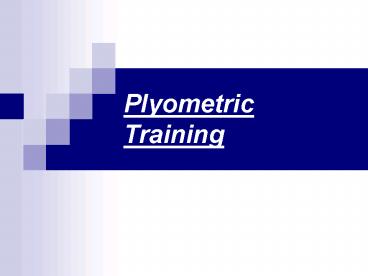Plyometric Training PowerPoint PPT Presentation
1 / 11
Title: Plyometric Training
1
Plyometric Training
2
History of Plyometrics
- First formalized in the early 1960s as a
scientific training system by Dr. Yuri
Verkhoshansky - Earliest published use of the term seems to be in
a Soviet publication in 1966 - Verkhoshansky favored the term shock method to
distinguish between naturally occurring
plyometric actions in sport and the training
system he devised to develop speed-strength
3
What are Plyometrics?
- Plyometric action basically consists of
stimulating the muscles by means of a sudden
stretch preceding any concentric voluntary effort - It is characterized by a reflexive action,
referred to as stretch-shortening action, between
the end of the eccentric braking phase, and the
beginning of the concentric acceleration phase - Defined by an amortization phase of less than .15
sec - Not to be confused with the training system used
to develop speed-strength (Mel Siff Yuri
Verkoshanky often used the term powermetrics) - It occurs naturally in virtually all sporting
actions
4
Steps in Plyometric Action
1. Initial momentum
5. Final momentum
2. Eccentric contraction
4. Rebound phase
3. Amortization
5
Why Plyometrics?
- Maximizing kinetic energy by increasing stored
energy has shown significant increases in power
output - Assists in the development of speed and reactive
ability - Virtually all sporting actions are performed at
high velocities - Easy to implement
- Most athletes enjoy plyos, and therefore show
positive results relatively quickly
6
Myths about Plyometric Training
Myth
Truth
- Dangerous to joints
- Complex drills or elaborate equipment must be
used - High reps lead to fatigue resistance
- SAID principle applies to joints (bone and
cartilage building increases with impact) - Simplicity, technical correctness favored
- High reps become jump training, not plyometric
7
Who should use Plyometrics?
- Running, jumping, throwing, changing direction
and other ballistic motions are part of most
anaerobic sports - Aerobic sports can use low level plyometrics in
conjunction with a resistance training program to
increase anaerobic power - ANYONE wanting to run faster, jump higher,
throw farther or move quicker can benefit from
plyometric training!!
8
When to use Plyometrics
- A plyometric program should be implemented in an
athletes off-season and pre-season phases - Plyometric training can occur in-season, but
should be of less volume than off-season or
pre-season - Lower level, less intense plyos should make up
most of your off-season volume, while higher
intensity plyos are performed in the pre-season - Generally done prior to weight bearing exercise,
but can also be incorporated during weight
lifting as supersets or complex sets - A speed, agility plyometric day can be
incorporated into your program as well
9
Preparation for training
- Develop technique Initial posture, landing
posture - Develop strength
- Lower body Squat 1RM 1.5xBW
- Upper body Bench 1RM BW
- or 5 clap push-ups in a row
- Develop speed
- Lower squat 5 reps _at_601RM in 5 sec.
- Upper bench 5 reps _at_601RM in 5 sec.
- Develop balance
10
How to use Plyometrics
- Repetitions should not exceed 5-8 in a particular
set - Should be preceded by a good warm-up involving
the muscles to be activated - Aim to increase speed of movement and reaction
time before increasing the intensity of the
exercise (drop height, etc) - Amortization phase must be extremely short (less
than .15 sec.) - Make sure to incorporate full rest periods
11
(No Transcript)

